| There Is No Place For Hockey In The Indian Sports Mix |
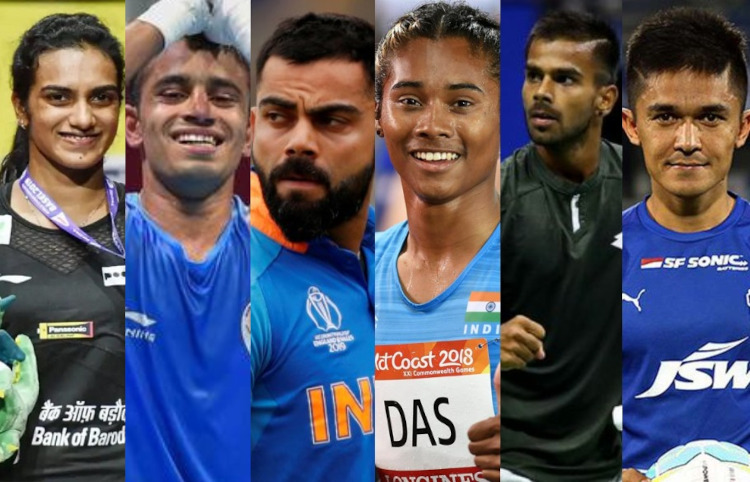
 here
is no place for Indian hockey in the Indian sports mix, as seen by the
metrics below. here
is no place for Indian hockey in the Indian sports mix, as seen by the
metrics below.
Sports Leagues: Cricket has IPL, football has ISL
and badminton has PBL. There are professional leagues in India for
kabaddi (PKL), volleyball (PVL) and wrestling (PWL). Table tennis has
its own league - Ultimate Table Tennis. The Hockey India League
has been missing in action since the 2017 edition.
Television Viewership: Young sports fans have a surfeit of sports to follow on
Indian television. IPL season viewership is over 400 million. PBL season viewership is
in the realm of 160 million. ISL and PBL have season viewership of
around 130 million. Ultimate Table Tennis season viewership is around 16
million. Currently, there are more people watching table tennis than
hockey on Indian television.
Sponsors: The IPL title sponsorship was ₹2,199
crore for 5 years (Vivo). The PKL title sponsorship is ₹262
crore for 5 years (also Vivo). Hero Moto Corp, which used to sponsor
hockey, has a 3-year, $25 million title sponsorship
deal with the ISL. The PBL has a title sponsorship of around ₹12
crore by Vodafone. If and when Indian hockey wakes up from its slumber, where is
the money left for corporate sponsorship of a hockey league?
Endorsements: More televised sports equals more
viewership eyeballs which translates to product endorsements for the
stars. Virat Kohli and Mahendra Singh Dhoni have over ₹100
crore in endorsments. Sachin Tendulkar retired back in 2013, and has ₹40
crore in endorsements. Badminton star P. V. Sindhu endorses 11
products for ₹35 crore. There is currently not a single
Indian hockey player who has endorsements.
Celebrity Assocation: Celebrities are associated
with most sports in India except hockey. The ISL has film stars Salman
Khan, Ranbir Kapoor, Abhishek Bachchan, Chiranjeevi and Nagarjuna as
team owners. The IPL has Shah Rukh Khan, Preity Zinta and Juhi Chawla as
team owners. Sports star Sachin Tendulkar is a team owner in the PBL,
while Virat Kohli is a team owner in the PWL. Without a televised or
on-ground product, there is no reason for celebrities to associate
themselves with hockey.
While Indian hockey continues to dwell on its past, other sports in
India are moving past hockey in terms of key metrics that determine the
health of a sport, such as sporting leagues, television viewership and
corporate sponsorship.
|
| World Cupper And Animal Lover Jasjit Singh Kular |
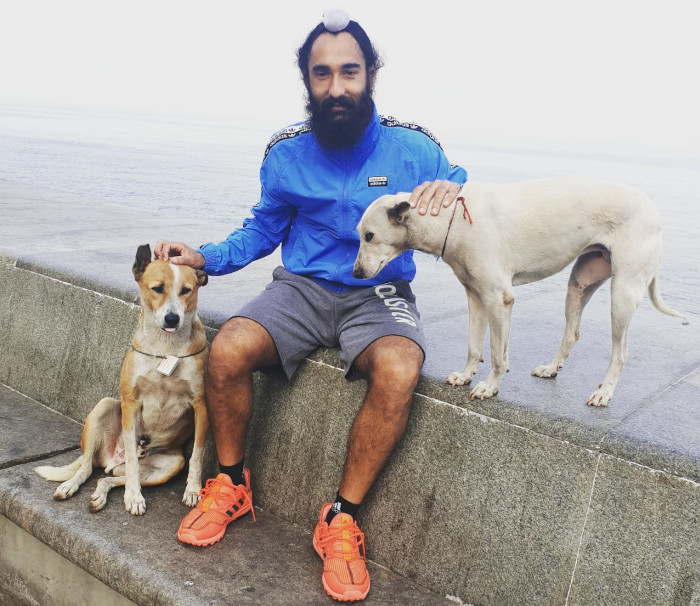
Article courtesy Stick2Hockey.com
 asjit
Singh Kular, former India player, comes from a family of doctors.
Although not one himself, the defender and drag-flicker extends his
pedigree to the care and well being of stray animals who battle the odds
for survival. asjit
Singh Kular, former India player, comes from a family of doctors.
Although not one himself, the defender and drag-flicker extends his
pedigree to the care and well being of stray animals who battle the odds
for survival.
Jasjit has three pet dogs; his village home in Sansarpur had a range
of animals - cows, buffaloes and numerous birds - which developed a love
for animals in him.
The Sansarpur hero, who donned India colours at the The Hague Hockey
World Cup six summers ago, shuttles between his job with the Railways,
keeping fit, and assisting an NGO called
Animal Protection Foundation which cares for strays.
"Dogs have suffered as the lockdown had meant restaurants and
eateries shut down, thereby depriving them of food," he revealed. "I
donned PPE gear in the early days of the Covid-19 pandemic to help stray
animals in trouble. We helped 300-400 dogs a day. Cows and buffaloes
face survival challenges too, especially the male species which are
discarded by their owners as they have no commercial value."
Jasjit explained, "There's little being done on the ground to save
these animals. And this neglect leads to animal behaviour borne out of
hunger and frustration that can harm humans, for no fault of the
animals."
Jasjit appears to be a thoughtful and caring citizen, and a worthy
ambassador of the sport. On 6th July, when the lockdown was at its
severest phase, Jasjit made the following request through his social
media account:
It's a humble request to everyone to donate at least ₹100
every month from your savings to Animal Protection Foundation so that we
can carry out surgeries, medicines, boarding of injured dogs,
transportation, doctors' fee and many other daily expenses. Your ₹100
can collectively become thousands, and will be helpful to treat animals
everyday. I would like to share that our NGO is under debt right now. We
need around ₹50K - 60K every month to carry out our
operations."
Stick2Hockey.com requests interested visitors to open their heart and
do their bit towards the kind-hearted and strong-willed Jasjit Singh
Kular's chosen cause.
|
| Hockey In Pre-Independent India Of 1920 |
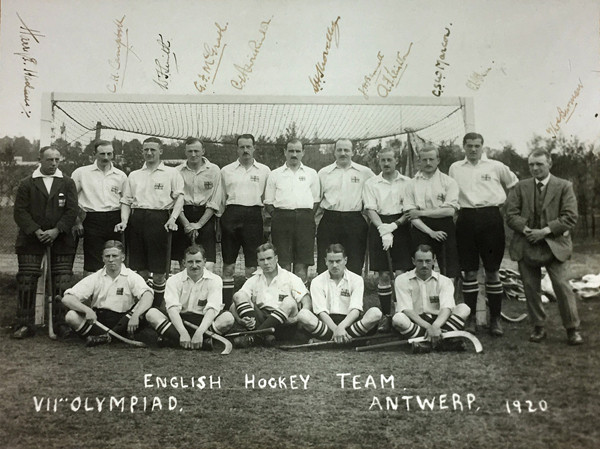
Article by K. Arumugam of Stick2Hockey.com,
Photograph credit Hockey Museum
 he
year 1920 marked an important phase for Indian hockey. The Beighton Cup,
the oldest trophy outside of Europe, had celebrated its silver jubilee
early that year. Named after the then Legal Remembrancer of the
Government of Bengal, and the donor of the trophy, Mr. T. D. Beighton,
the cup was stolen a few years prior but a replica was put in place to
continue the legacy. Xavier's Club, an exclusive Anglo-Indian outfit,
won the silver jubilee edition of the Beighton Cup, beating Calcutta
Football Club. he
year 1920 marked an important phase for Indian hockey. The Beighton Cup,
the oldest trophy outside of Europe, had celebrated its silver jubilee
early that year. Named after the then Legal Remembrancer of the
Government of Bengal, and the donor of the trophy, Mr. T. D. Beighton,
the cup was stolen a few years prior but a replica was put in place to
continue the legacy. Xavier's Club, an exclusive Anglo-Indian outfit,
won the silver jubilee edition of the Beighton Cup, beating Calcutta
Football Club.
1920 also saw the famous Lakshmibilas Cup won by the Dacca (now Dhaka
and capital of Bangladesh) based Bisveswar Sports Club. It was big
honour for both the Xaverians and Bisweswarians as it was their maiden
success on such a big stage.
About 2,000 km away from Calcutta (now Kolkata) where these two
events took place in 1920, the famous Aga Khan competition was also a
grand success in Bombay (now Mumbai). Lahore (now in Pakistan) based civil team, North Western
Railways, won the 24th edition, narrowly defeating Hornets Club. Also,
after hovering over different venues, the Aga Khan Cup finally found its
home, the Bombay Gymkhana Club in Bombay.
What happened at Kolkata and Mumbai proved the fact that hockey had
matured as a competitive sport in India. Vast stands, triple the number
of participating teams compared to their maiden events, good gate
collection and newspaper coverage meant the Indian hockey was poised to
go places.
In fact, it did.
No fewer than a dozen schools, all catering to affluent sections of
society, ran hockey teams and were successful in producing quality
players. Those schools, mostly of the boarding variety, were located
either in metro cities or hill stations such as Wellington, Darjeeling,
Mussorie, Mount Abu, etc. The majority of these institutions were run by
either Irish Christian Brothers or Jesuit Priests.
There was also another front where hockey was actually taking a giant
leap. It was in the cantonments. Besides annual inter and intra-military
hockey competitions, a new hockey tournament called the Coronation Cup was
instituted in Delhi.
Back in 1911, King George V and Queen Mary had visited India for the
Delhi Durbar. At Coronation Park, which lies 15 km away from present
President of India's Rashtrapati Bhavan, the visiting King had announced the
moving of India's capital from Calcutta to Delhi. On that occasion, in
the run up to the grand reception, hockey teams all over India had assembled
for what came to be called the Coronation Cup.
However, 1920 is also remembered for a globally significant happening
in hockey. That year, in the Belgian city of Antwerp, field hockey was
played at the Olympics for only the second time.
The 1920 Olympic hockey tournament was played as a four-nation round
robin event. Great Britain beat Denmark 5-1, hosts Belgium 12-1, and
were awarded a walkover in their final game against France to secure
their second successive Olympic hockey gold.
|
| Hockey In The Kolhapur District of Maharashtra |
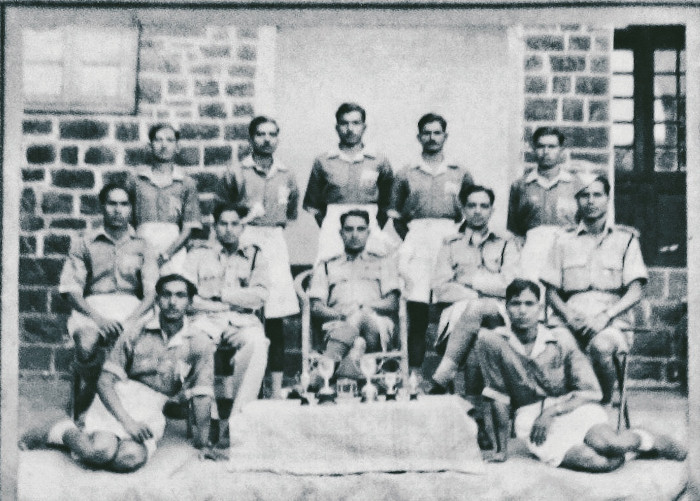
Rajaram Rifles Hockey Team of the erstwhile
Kolhapur princely state, 1946
Article by Ranjit Dalvi,
photo by Amar Bhosale, courtesy Stick2Hockey.com
 olhapur
State was founded in the year 1700 by Maharani Tarabai Bhonsale, the
widow of Chhatrapati Rajaram, the second son of Chhatrapati Shivaji. She
turned out to be the nemesis of Aurangzeb, who had marched to the Deccan
with the fond hope of capturing Kolhapur easily. olhapur
State was founded in the year 1700 by Maharani Tarabai Bhonsale, the
widow of Chhatrapati Rajaram, the second son of Chhatrapati Shivaji. She
turned out to be the nemesis of Aurangzeb, who had marched to the Deccan
with the fond hope of capturing Kolhapur easily.
The first ever organised battalion of Indian natives, the Maratha
Light Infantry (MLI) was formed in 1768 by the British. The same
regiment popularised hockey in the 1950s and 1960s.
Olympians Shankar Laxman (1956, 60, 64 Olympics), Bandu Patil (1964
Olympics) and Major Shantaram Jadhav (1960 Olympics) always struck a
chord in the hearts of hockey aficionados. They all played for MLI, and
were in the forefront when the MLI won major tournaments in the country.
The MLI headquarters at Belgaum (Karnataka) is just two hours drive
from Kolhapur (Maharashtra).
The Federation and state hockey units should have made efforts to
form district-level and taluka-level units to build a proper grassroot
structure in hockey. With both the Indian Hockey Federation and Hockey
India having failed to do that, it really hurts.
To stress the fact, let us take the example of Kolhapur, my native
district. Although the origins of the game there are not clear, the
first documented proof is an old photograph of Line Bazar Club posing
with a trophy in 1938 or 1939 after winning a hockey tournament. It
would be safe to surmise that the sport must have originated in Kolhapur a few years
before that.
The Rajaram Rifles Training Centre, the State's own police force, won
the hockey title in the 1945-46 edition of the Kolhapur Olympic Sports
event.
There are presently 18 hockey clubs in Kolhapur, 14 of which are in
Line Bazar, an area which gets its name from the infantry lines set up
by the British after they established a residency in the princely state. There
are schools and colleges which promote hockey, not just in the city but
also in nearby towns like Ichalkaranji which is a flourishing textile
manufacturing hub, and taluka places like
Islampur and Bhudargad-Gargoti. Most of the hockey is placed on chat or
gravel pitches here.
Despite having such a broad base, those at the helm of affairs at the
Maharashtra Hockey Association failed to realise the potential of this
region. Why did it take 33 years after independence to form the Kolhapur
district hockey association?
The story of hockey in India would have been quite different with a
proper structure in place in districts such as Kolhapur. And mind you,
India has 718 districts now! Imagine the amount of raw talent that's
waiting to be tapped at the district and taluka level in the country!
-- Author Ranjit Dalvi is a sports writer, radio and television
commentator, national-level umpire, and a former Managing Committee
member of The Mumbai Hockey Association Ltd.
|
| Photograph of the Month |
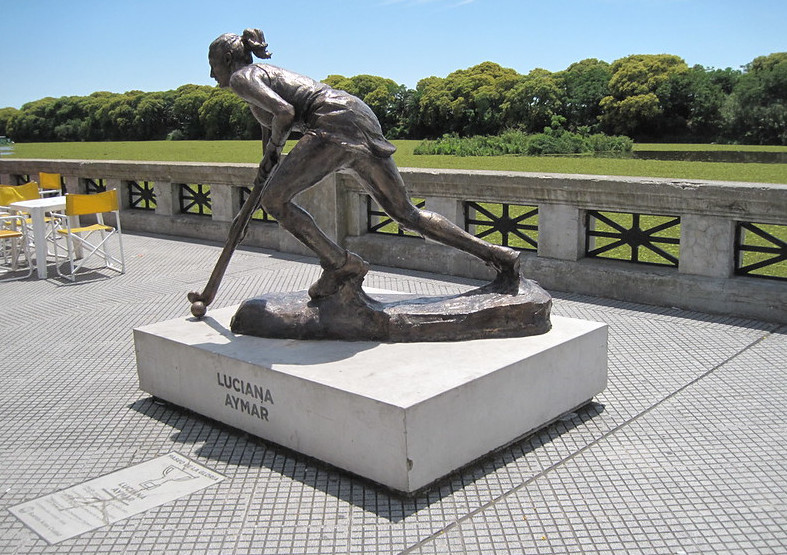
 he
Photograph of the Month for October 2020 is of Argentinean hockey legend
Luciana Aymar, who has a statue in her honour in Buenos Aires. Luciana
was one of the stars of the Las Leonas, a term that was born during the
2000 Sydney Olympics to represent the fighting lionesses of the
Argentinean national women's hockey team. he
Photograph of the Month for October 2020 is of Argentinean hockey legend
Luciana Aymar, who has a statue in her honour in Buenos Aires. Luciana
was one of the stars of the Las Leonas, a term that was born during the
2000 Sydney Olympics to represent the fighting lionesses of the
Argentinean national women's hockey team.
During their match against Netherlands at the Sydney Games,
Argentinean players placed the image of a lioness on their shirts for
the first time. The image was designed by then-player Inés
Arrondo, together with coach Sergio Vigil's sister-in-law. Argentina won
that match, and Las Leonas were born.
On the occasion of the 20th anniversary of the formation of Las
Leonas, Marcelo Bielsa, soccer coach of Leeds FC, wrote the following to
the team.
"Not all teams have their own name. Like all idols, Las Leonas
are a popular property that makes the Argentine people proud, but
especially the group of women which gave rise to it 20 years ago. The
Lionesses, a symbol of national sport, are part of the heritage that our
country, like every country, needs."
Since 2000, Argentina women have won two World Cups (2002, 2010), a
record seven Champions Trophy golds (2001, 2008, 2009, 2010, 2012, 2014,
2016) and two Olympic silver medals (2000, 2012).
|
| Money Matters |
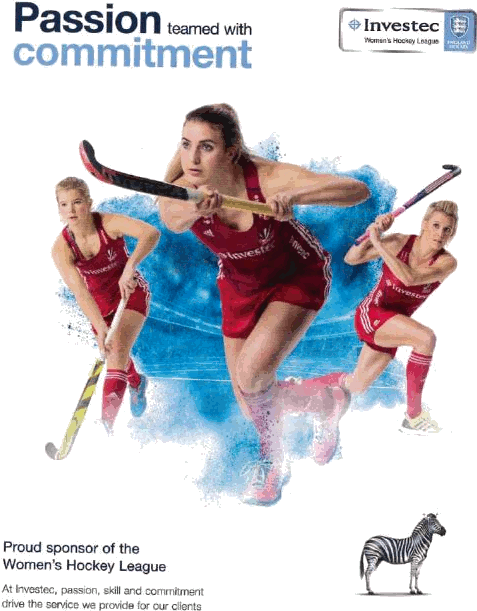
Article by Martin Ross, courtesy SportBusiness.com
 nvestec,
the international bank and wealth management group, will not continue
its sponsorship of England Hockey and Great Britain Hockey. The firm
came on board nine years ago as a sponsor of the Great Britain and
England women's international hockey teams, but will not extend its
backing beyond the expiry of the current contract in August 2020. nvestec,
the international bank and wealth management group, will not continue
its sponsorship of England Hockey and Great Britain Hockey. The firm
came on board nine years ago as a sponsor of the Great Britain and
England women's international hockey teams, but will not extend its
backing beyond the expiry of the current contract in August 2020.
England Hockey said, "When the relationship with Investec began in
2011, it was pioneering and far-sighted to enter into a partnership with
a women's sport. This creativity, vision and courage has been rewarded,
and a decade later and with progress to make, women's sport is in a very
different place in the national consciousness and mind-set of sponsors."
The news leaves the women's team searching for a new sponsor in time
for the Tokyo 2020 Olympics, which have been pushed back by 12
months because of the Covid-19 outbreak.
Investec was England Hockey's principal partner, sitting above a pool
of official partners and official suppliers in the governing body's
sponsorship pyramid. In 2019, England Hockey brought in a total of
£449,000 (€508,000/$551,700) in sponsorship revenues.
Investec had also been the principal partner of the Women's Hockey
League, Schools Championships for girls and Investec London Cup - an
international women's hockey invitational tournament. The wealth
management company had signed a four-year sponsorship extension in 2016.
|
| Media Matters |
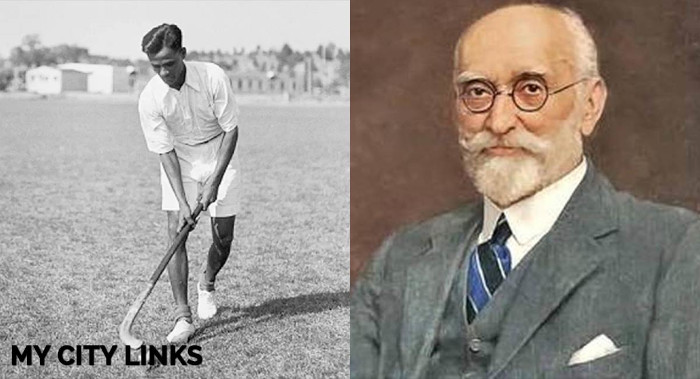
Article and photograph credit My City Links
 n
the occasion of National Sports Day on August 29, a webinar was
organised by the Naval Tata Hockey Academy, Bhubanesvar, to remember
hockey magician Major Dhyan Chand and visionary Sir Dorabji Tata. n
the occasion of National Sports Day on August 29, a webinar was
organised by the Naval Tata Hockey Academy, Bhubanesvar, to remember
hockey magician Major Dhyan Chand and visionary Sir Dorabji Tata.
Moderated by Rajiv Seth, Project Director, Naval Tata Hockey Academy,
and Diksha Tiwari, Communications Head, XEBS Centre of Excellence in
Sports Management, the session started with a tribute to Sir Dorabji
Tata and Major Dhyan Chand, showing interesting glimpses into their
lives.
Farzan Heerjee, Chief of Protocol and Sports, Tata Steel, spoke about
how Sir Dorabji Tata seeded the sporting culture in India and made
sports an integral part of the social fabric of the Tata Group.
Panelists included luminaries like Gurbux Singh, Ashok Kumar, Dr.
Vece Paes, his son and Indian tennis great Leander Paes, and hockey
defender Dilip Tirkey. They shared memories of the country's golden
years of sports, and highlighted key issues for the future.
Ashok Kumar revealed how he skipped his B. Com examination in Kota to
join the Mohan Bagan hockey team, so that he could play under the wings
of Gurbux Singh and Dr. Vece Paes. He also shared how his iconic father
was a simple man at home despite greatness following Major Dhyan Chand
everywhere.
Gurbux Singh and Dr. Vece Paes recollected their Olympic days, while
Leander reminisced about his young days growing up with "Gurbux uncle"
and his father, and learning leadership skills from them, both Olympians.
Dilip Tirkey, now Chairman of Odisha Hockey Promotion Council, spoke
about his young days in Sundargarh, and the inspiration he received from
some of the greats of Indian hockey like Pargat Singh.
The session ended with some questions from the students of the girls'
hostel of the academy and the audience.
|
| Fun With Numbers |

Statistics by B. G. Joshi
 he
October 2020 edition of Fun with Numbers is on Olympic or World titles won
by both parent and child. he
October 2020 edition of Fun with Numbers is on Olympic or World titles won
by both parent and child.
- 3 generations of the Keller family have played in the Olympic
hockey final - Erwin Keller (1936 silver), his son Carsten Keller
(1972 gold), and his children Andreas (1992 gold), Natscha (2004
gold) and Florian (2008 gold).
| Country |
Parent |
Parent Gold Medal |
Child |
Child Gold Medal |
| India |
Dhyan Chand |
1928, 32, 36 Olympics |
Son Ashok Kumar |
1975 Kuala Lumpur World Cup |
| |
Ahmed Sher Khan |
1936 Olympics |
Son Aslam Sher Khan |
1975 Kuala Lumpur World Cup |
| Pakistan |
Munir Dar |
1960 Rome Olympics |
Son Tauqeer Dar |
1984 Los Angeles Olympics |
| Germany |
Carsten Keller |
1972 Munich Olympics |
Son Andreas Keller |
1992 Barcelona Olympics |
| |
|
|
Daughter Natascha Keller |
2004 Athens Olympics |
| |
|
|
Son Florian Keller |
2008 Beijing Olympics |
|
![]()